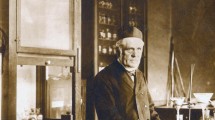Abstract
Chemical elements are the bricks with which Chemistry is build. Their names had a history, but part of it is forgotten or barely known. In this article the forgotten, no more used, never used, and alternatively used names and symbols of the elements are reviewed, bringing to us some surprises and deeper knowledge about the richness of Chemistry. It should be stressed that chemical elements are important not only for chemists but for all people dealing with science. As in any other aspect of our lives, we tend to better understand something by knowing his history. By knowing them we can have a deeply understanding of how science evolves and how it is influenced by our human aspects.
Similar content being viewed by others
References
About Chemistry. (2012). About.com. Chemistry. Element symbols not in use (updated 2012; accessed 2012 Sep 2) http://chemistry.about.com/od/elementfacts/a/discontinued-element-symbols.htm.
Andraos, J. (2011). Department of Chemistry-York University (updated 2011; accessed 2012 August 1) http://careerchem.com/NAMED/Elements-Names.pdf.
Ball, D. W. (1985). Elemental etymology: Whats in a name? Journal of Chemical Education, 62, 787–788.
Bell, I. R., Lewis, D. A., Brooks, A. J., Lewis, S. E., & Schwartz, G. E. (2003). Gas discharge visualization evaluation of ultramolecular doses of homeopathic medicines under blinded, controlled conditions. Journal of Alternative and Complementary Medicine, 9, 25–38.
Bermejo, M. R., González-Noya, A. M., & Vázquez, M. (2006). O Nome e o Símbolo dos Elementos Químicos (1st ed., pp. 31–43). Xunta de Galicia: Santiago de Compostela.
Chemeurope (2012). Chemeurope.com. Darmstadium (updated 2012; accessed 2012 September 21) http://www.chemeurope.com/en/encyclopedia/Darmstadtium.html.
Coplen, T. B., & Peiser, H. S. (1998). History of the recommended atomic-weight values from 1882 to 1997. Pure and Applied Chemistry, 70, 237–257.
DeArdo, A. J. (2003). Niobium in modern steels. International Materials Reviews, 48, 371–402.
De Unamuno y Jugo M. (1924). Essay: “A selecção dos Fulanos” in Essays and Soliloques, Harrap ed, London.
Emsley, J. (1998). The elements (3rd ed., pp. 278–281). Oxford: Clarendon Press.
Etimol (2012). List of chemical element name etymologies (updated 2012 April 11; accessed 2012 September 20) http://en.wikipedia.org/wiki/List_of_chemical_element_name_etymologies.
Fernelius, W. C., Loening, K., & Adams, R. M. (1975). Notes on nomenclature. Journal of Chemical Education, 52, 583–584.
Friend, J. N. (1961). Man and the chemical elements (2nd ed.). London: Charles Griffin.
Froelich, P. N., & Andreae, M. O. (1981). The marine geochemistry of germanium: Ekasilicon. Science, 213, 205–207.
Geotimes, (2007). Mineral resource of the month: Niobium(Columbium). Geotimes, 52, 21–21.
Glockler, G. (1925). Predicted ionization-potentials of niton and hydrofluoric acid. Philosophical Magazine, 50, 997–1001.
Gray, R. W., & Ramsay, W. (1911). The density of niton (“radium emanation”) and the disintegration theory. Proceedings Royal Soc London Series A, 84, 536–550.
IUPAC. (1994). Names and symbols of transfermium elements (IUPAC recommendations 1994). Pure and Applied Chemistry, 66, 2419–2421.
IUPAC. (2002). Naming of new elements. Pure and Applied Chemistry,74(5), 787–791. http://media.iupac.org/publications/pac/2002/pdf/7405x0787.pdf.
Jeannin, Y. (2005). An unedited letter of Sir William Ramsay on the discovery of argon. Comptes Rendue Chimie, 8, 3–7.
Koppenol, W. H. (2002). Naming of new elements—(IUPAC Recommendations 2002). Pure and Applied Chemistry, 74, 787–791.
LBNL. (2012). Lawrence Berkeley National Laboratory. Based on the Glenn T. Seaborg’s lecture, An Early History of LBNL (accessed 2012 September 4) http://www.lbl.gov/LBL-PID/Nobelists/Seaborg/65th-anniv/14.html.
Le coq de Boisbeaudran, P.-E. (1877). About a New Metal, Gallium. Annales de Chimie, 10, 100–141.
Leal, J. P. (2011). Chemical elements: what’s in a name? Science, 334, 176.
Luidold, S., Antrekowitsch, H., & Ressel, R. (2007). Production of niobium powder by magnesiothermic reduction of niobium oxides in a cyclone reactor. International Journal of Rerfactory Metals and Hard Materials, 25, 423–432.
Mendeleyev, D. (1871). Die periodische Gesetzmassigkeit der chemischen Elemente. Ann Chem Phar Suppl, 8, 133–229.
Mollinger, H., Schneider, R., & Walach, H. (2009). Homeopathic Pathogenetic Trials Produce Specific Symptoms Different from Placebo. Forsch Komplementmed, 16, 105–110.
Rajkumar, R., Srivastava, S. K., Yadav, M. C., Varshney, V. P., Varshney, J. P., & Kumar, H. (2006). Effect of a Homeopathic complex on oestrus induction and hormonal profile in anoestrus cows. Homeopathy, 95, 131–135.
Ramsay, W., & Gray, R. W. (1910). La densité de l’emanation du radium. Comptes rendus hebdomadaires de Seances de l’Academie des Sciences, 151, 126–128.
Ramsay, W. (1914). Niton as a therapeutic agent. Lancet, 1, 1481–1483.
Rao, M. L., Roy, R., Bell, I. R., & Hoover, R. (2007). The defining role of structure (including epitaxy) in the plausibility of homeopathy. Homeopathy, 96, 175–182.
Rayner-Canham, G. W., & Zheng, Z. (2008). Naming elements after scientists: an account of a controversy. Foundations of Chemistry, 10, 13–18.
Ringnes, V. (1989). Origin of the names of chemical elements. Journal of Chemical Education, 66, 731–738.
RSC. (2012). Royal Society of chemistry, Chemistry in Its Element—Americium (updated 2012; accessed 2012 September 2) http://www.rsc.org/chemistryworld/podcast/Interactive_Periodic_Table_Transcripts/Americium.asp.
Sargeson, A. M., McCleverty, J. A., Koppenol, W. H., Arduengo, A. J., Coucouvanis, D. N., de Bolster, M. W. G., et al. (1997). Names and symbols of transfermium elements. Pure and Applied Chemistry, 69, 2471–2473.
Sevar, R. (2007). Aurum muriaticum natronatum—four case reports. Homeopathy, 96, 258–269.
Sime, R. L. (2000). The search for transuranium elements and the discovery of nuclear fission. Physics in Perspective, 2, 48–62.
Van der Krogt, P. (2012). Names that did not make it. Peter van der Krogt (accessed 2012 Jun 28). Available from: http://www.vanderkrogt.net/elements/didnot.php.
Walker, T. L. (1923). Hafnium or jargonium. Nature, 112, 831–831.
Weeks, H. M., & Leicester, H. M. (1968). Discovery of the elements (7th ed.). Journal of chemical education: Easton, PA.
Winkler, C. A. (1886). Germanium, Ge, ein neues, nichtmetallisches Element. Berichte der Deutschen Chemischen Gesellschaft, 19, 210–211.
Wotiz, J. H., & Trimble, R. F. (1975). Story behind story: What happened to alabamine, virginium and illinium. Journal of Chemical Education, 52, 585–585.
Zingales, R. (2005). From masurium to trinacrium: The troubled story of element 43. Journal of Chemical Education, 82, 221–227.
Author information
Authors and Affiliations
Corresponding author
Rights and permissions
About this article
Cite this article
Leal, J.P. The Forgotten Names of Chemical Elements. Found Sci 19, 175–183 (2014). https://doi.org/10.1007/s10699-013-9326-y
Published:
Issue Date:
DOI: https://doi.org/10.1007/s10699-013-9326-y




